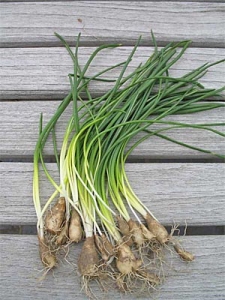Stalking The Wild Onion
By Elizabeth Cornell Fake, Fairfax Master Gardener
Now that spring is right around the corner, you are probably starting to look critically at your lawn and noticing some clumps of tall, thin, tubular grasses sticking out above the turf. Your first guess might be that wild onion has sprouted in your yard, but it could be wild garlic, too. Both are common weeds and look much alike. Wild onion (Allium canadense) plants looks like the spring onions you buy at the grocery store for salads, but they are more slender and definitely taller by about 6 to 12 inches. They have solid, flat leaves and can be curly at the top. Wild garlic (Allium vineale) looks very similar to wild onion, but has only two to four hollow leaves. Both grow from bulbs, but wild-onion bulbs have a fibrous, central bulb. Wild garlic has offset bulbs enclosed in a papery membrane. Both are identifiable by their sharp, acrid smell, with wild onion smelling like onion and wild garlic smelling like both onion and garlic.

Wild garlic (Allium vineale)
If you want to remove these plants from your garden beds or lawn, it will take strong will and determination. You can use a weed popper to pull them out by hand, but if you leave behind any part of the roots, the plant will probably come back. Pulling is best done when the soil is moist; the plants slide out easily. In garden beds, glyphosate will control both wild garlic and wild onion, if the bulbs are not dormant, but you must be careful not to spray the weed killer on other plants. For lawns, the selective weed killers that contain 2, 4-D, dicamba, and MCCP work reasonably well against wild garlic (treat in fall) and wild onion (treat in spring). But it is likely you will need multiple treatments. You might just decide to have a policy of peaceful coexistence with these weeds.

Wild onion (Allium canadense)
However, if you are intent on harvesting wild onions for consumption, be cautious. There are pretenders! Beware especially of the wild onion’s evil twin, a wildflower called Star of Bethlehem (Ornithogalum umbellatum) that is poisonous and can be highly toxic to both humans and animals who ingest it. The poisonous onion-grass is a little shorter than wild onion and has flat leaves very similar to grass. When you dig them up, they will look like wild onions with the same round, white bulbs. Be sure to check for the strong, undeniable onion odor. If they have no smell, put them aside and continue to look for other plants.

The poisonous twin — Star of Bethlehem (Ornithogalum umbellatum
Resource
Wild Garlic and Wild Onion, Missouri Botanical Garden